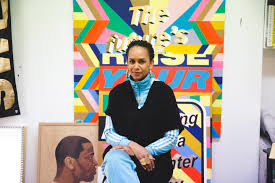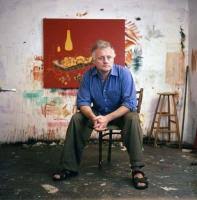Two hugely anticipated exhibitions
Lakwena Mciver’s Homeplace
Stephen Chambers’ The Court of Redonda
will mark the re-opening of Hastings Contemporary after
the UK’s latest national lockdown.
Lakwena Maciver, one of the UK’s most exciting contemporary black artists creates painted prayers and meditations, which respond to and re-appropriate elements of popular culture. Central to her practice are words, used as both images and anchors of meaning.
Exploring the role of the artist as myth-maker, with their use of acid-bright colour and bold typographic text, her paintings act as a means of decolonisation, subtly subverting prevailing mythologies. The approach is instinctive and autodidactic, producing visceral, rhythmic and immersive panel paintings, iconic murals and installations.
Lakwena’s most recent body of work exhibited for the first time at Hastings Contemporary focuses on the interplay between her practices as both artist and mother of two young sons. Responding to feminist author bell hooks’ essay Homeplace (a site of resistance), and in the tradition of African women across the diaspora, Lakwena has been painting the walls of her home to create a space of affirmation, empowerment and resistance upon which will sit her panel paintings.
Challenging both the external and the internalised voice of mass media, Lakwena has created works in the public realm internationally, from installations at Tate Britain, Somerset House, Facebook and the Southbank Centre in London, to a juvenile detention centre in Arkansas, a monastery in Vienna, and the Bowery Wall in New York City.
Lakwena says “What’s this exhibition about? Well it’s about me ‘singing over’ my home, my family, my community. I’m an artist and a mother, and I guess I’m looking at where those two roles cross over. My art is concerned with mythologies; things we hold to be true and I want to tell the truth to my kids. These are words of affirmation, words that will encourage, warn and inspire. I know that they go out into the big wide world and I can’t control what happens out there. They’ll hear things and be influenced by things that I have no control over. But I can ensure that in my home I am sending them clear messages about who they are, their value, their worth, what to do in times of need, where to go to for help, what to set their hearts on, what is important. So that’s what these paintings are about. My intention is to create a safe space for them. As these paintings and images of them travel, literally and virtually, my hope is that they might act as sparks to encourage others to define spaces of safety, and also as signs to point people to places of safety”.
First shown at The Venice Biennale in 2017, Stephen Chambers’ The Court of Redonda depicts a cast of 101 imaginary courtiers inspired by a literary legend that developed around the tiny uninhabited Caribbean island of Redonda. This legend took shape as a fantasy in the mind of Matthew Dowdy Sheill, a merchant trader who claimed the island in 1865 and gave himself the title of King. The title passed down to his son, who decided that it should be given to poets and novelists as a form of literary honour. The celebrated novelist Javier Marías was a recent sovereign and his appointment of courtiers, including film director Pedro Almodóvar and novelists AS Byatt and Ian McEwan, inspired Chambers to create his own imaginary court of Redondans: not just poets, philosophers, artists and writers, but also patients, pharmacists, harlots and “bums”.
Chambers explains: ‘It’s a construct, – an idea that I was intrigued with. I wrote to Javier Marías, and in that correspondence, I suggested that I would paint portraits of the court. The paintings are not portraits from life, and they’re not depictions of real people, -they are invented. I wanted to present a wide range of motley ne’er-do-wells and in a way celebrate their ordinariness. There is that line that I kick around my head which goes ‘the ordinary is more extraordinary than the extraordinary’’.
The Court of Redonda is joined in this exhibition by other series of works by Chambers exploring histories, both real and imagined.
Stephen Chambers RA is one of the UK’s most revered artists, having exhibited widely around the globe, with more than 40 solo presentations including the Royal Academy of Arts in London in 2012 and at the Pera Museum, Istanbul in 2014. Chambers contemporary dance collaborations at The Royal Ballet, London with Ashley Page and Orlando Gough include Sleeping with Audrey (1996), Room of Cooks (1997,1999), and This House will Burn (2001)
Chambers work is held in many international collections including Arts Council England, Deutsche Bank, London, Downing College, Cambridge (at which he was the Kettle’s Yard/Downing College Fellow and later elected an Honorary Fellow), UK Government Art Collection, London, Metropolitan Museum, New York and The Victoria and Albert Museum, London.
Liz Gilmore Director of Hastings Contemporary says “Hastings Contemporary Gallery finishes this extraordinary year with two hugely exciting and thought-provoking exhibitions by two internationally significant artists: Lakwena and Stephen Chambers. Responding directly and positively to the challenges of our time Lakwena’s vibrant two-room exhibition will challenge and delight. Chambers’ stunning series of works take the viewer on an imaginative journey where we can reflect and learn on our own world order. Both exhibitions remind us of the vital role artists play as storytellers and mythmakers.
Covid-19 has challenged the resilience of the cultural sector. The trustees and I are very proud of the prodigious efforts of our small team delivering such meticulous installations at this challenging time. We would like to thank the exhibiting artists Lakwena and Stephen for their incredible openness and agility in responding to the changing brief and for their thoughtful and imaginative use of the gallery spaces. Visitors will be able to enjoy these exhibitions alongside the prophetic exhibition by Sir Quentin Blake ‘We Live in Worrying Times’. None of this would have been possible without the generosity and support of many incredible individuals and organisations who have supported us at this time.”
Hasting Contemporary Team overcame the logistical barriers that the pandemic created for galleries and museums across the world, enhanced by the investment from Hastings Borough Council, ACE and DCMS’ recovery funds. The team presented a series of stunning exhibitions throughout the year, while also trailblazing robotic technology to help combat social isolation and ensure they reached the widest possible audience. The year will culminate with these two dazzling shows opening in December.
Hastings Contemporary is planning a calendar of exciting new projects though out 2021, and will continue to curate world-class exhibitions and shows for all our audiences both on-line via our robot tours and in our much loved gallery, as and when it is allowed to open.


